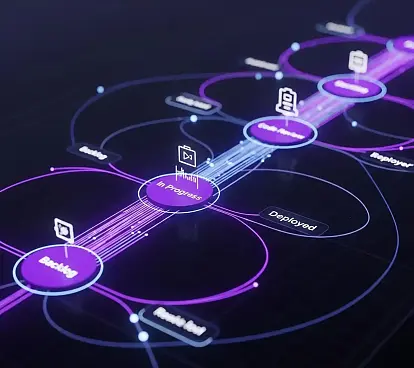
Low Code, the catalyst business applications
January 25, 2024
Today’s Low Code development platforms are redefining how we create business applications.
In an increasingly competitive digital market, delivery speed and responsiveness to changing user demands are crucial. Low Code development, a disruptive approach that has gained prominence in recent years, stands as an intriguing catalyst for streamlining modern software development, thereby accelerating companies’ application backlogs.
According to Gartner, by 2025, about 70% of applications will leverage Low Code technologies. This projection, though speculative, highlights the technology’s short-to medium-term significance within software development.
The problems of conventional development
Looking back to the 1940s, when modern programming was in its infancy, we relied on mainframes like the Mark I. The IBM Automatic Sequence Controlled Calculator, also known as Harvard Mark I, was the first real piece of programmable hardware. This mammoth machine, the size of a train car, featured 760,000 wheels, 800 kilometers of cable, and consumed as much electricity as a small town.
 Harvard-IBM Mark I Computer, right side of the computer. Cabot Science Building, Harvard University, Cambridge, Massachusetts.
Harvard-IBM Mark I Computer, right side of the computer. Cabot Science Building, Harvard University, Cambridge, Massachusetts.
Working with such a system was not only complex but fraught with challenges.
Firstly, programming took a long time, as machine code instructions were input through fragile punched tape, requiring manual review to ensure everything was correct and hoping none of the electromechanical components failed during execution.
Moreover, we are talking about a million and a half dollar computer from 1943. Programming for it was only within the reach of the U.S. Government and a few universities, so the cost of development was extremely high, not to mention its ROI.
The limited accessibility to these early computing giants meant that only a few had the opportunity to work with them, creating a significant barrier to the widespread adoption and democratization of software development. The democratization of software was a distant utopia.
Fortunately, a visionary from this exclusive group came up with an idea that would help to mitigate these issues for decades to come.
Democratizing software creation
Do you recognize the woman depicted below? Is the term “bug” familiar to you? Surely it is.
 Grace Murray Hopper, in her office in Washington DC, 1978, ©Lynn Gilbert
Grace Murray Hopper, in her office in Washington DC, 1978, ©Lynn Gilbert
This remarkable individual is Grace Hopper, one of the main reasons you’re reading this post. Hopper is often colloquially recognized for coining the term “bug” to describe software errors, but her influence in computing extends far beyond that. She was one of the most important computer scientist of the 20th century.
She participated in the design and construction of some of the most prominent computers of her time, created the first operational compiler in history, and contributed to the development of many programming languages, including the famous COBOL. Regarding this post’s topic, she’s also famous for promoting what has come to be called the democratization of software development. This initiative promoted the use of high-level languages over machine code or assembly programming, the paradigms used at that time.
This approach enabled faster, cheaper solutions development, accessible to other workgroups.
As Hopper herself said during the firs HOPL (History of Programming Languages) Conference, “the dual purpose of any programming language is to help write applications with minimal effort and enable non-specialists to solve problems using computers”.
Unfortunately, after successive updates in paradigms and technologies, 80 years after Hopper first revolutionized software development, we find ourselves in a similar situation.
In 2023, 85% of software projects are delayed, 66% incur cost overruns, and the professional skill gap is widening, with nearly 10K STEM positions unfilled in Spain alone. Thus, it’s time for a new democratization of software development.
How do we do it? The answer lies in Low Code.
Low Code to the rescue
Low Code is a technology that allows for rapid delivery of business solutions with minimal manual programming and reduced initial investment.
Rather than relying heavily on endless lines of code, this paradigm allows developers and those without extensive programming knowledge to create applications more agilely and efficiently through visual interfaces and configuration of existing components.
This approach promises not only to speed up the development cycles, but also to democratize the application creation process, allowing a wider rage of professionals to actively participate in software development.

Main strengths
Low Code technology is notable for being cloud native, eliminating the need for costly infrastructures. By operating in the cloud, it frees developers from hardware management concerns, allowing for more agile and transparent development.
Thanks to its simplicity, it’s accessible to all professional profiles, opening the door of application development to a wider range of individuals. Although professional development supervision is recommended, the visual interface and configuration of existing components make it easier for those without extensive programming knowledge to participate.
Moreover, Low Code emerges as a multi-device and multi-platform solution. This versatility allows developers to create applications that work seamlessly in different environments, optimizing the end-user experience.
Advantages of the paradigm
The agility of Low Code stands out as one of its most evident advantages. With significantly reduced development times, this technology enables a quicker response to the market’s changing needs and user demands. Developers can efficiently adapt to changes, maintaining the relevance of applications in an ever-evolving technological environment.
In terms of cost-effectiveness, it presents another standout feature. By minimizing development time and optimizing resource use, this technology offers significant cost savings. Organizations can achieve their software development goals more efficiently and economically.
Scalability becomes crucial for Low Code to adapt to changing demands. As it’s based on elements and behaviors, growth becomes simpler, allowing projects to evolve more fluidly as an organization’s needs change over time.
At the enterprise level, it excels by bringing to light projects that might never otherwise be undertaken. It facilitates the realization of innovative ideas by eliminating traditional barriers to software development, fostering a more democratic and participatory approaches to application creation.
Innovation is inherent to Low Code, especially when operating in aPaaS mode (platform as a service). This mode allows for the constant incorporation of additional functionalities, keeping solutions up-to-date and aligned with the latest technological trends.
Finally, security is integrally built into Low Code. From the initial coding of modules to the cloud service model, robust security measures are established to protect applications and sensitive data. This proactive approach to security contributes to the reliability and robustness of solutions developed with this technology.

Coexisting with High Code
In the dynamic environment of software development, the coexistence of Low Code and high code emerges an integral approach, recognizing the unique strengths and advantages each brings to the application creation process.
Low Code doesn’t seek to replace the traditional model, but rather to complement it synergistically. This strategic coexistence allows developers to choose the most suitable tool based on the project context and team skills.
The collaborative nature of both enables development teams to harness the best of both worlds. Critical and complex applications can be initiated using high code, while projects that are faster and agility-oriented can benefit from the Low Code approach.
Rather than being seen as competitors, they unite to catalyze innovation and maximize efficiency in software development. In summary, the harmonious coexistence of Low Code and high code is not only possible but highly beneficial. Together, they form a dynamic duo that boosts creativity, efficiency, and responsiveness in the ever-changing landscape of software development.
A partner for every need
Within its Low Code project ecosystem, SNGULAR collaborates with Microsoft Power Platform and Mendix
Both offer tools and services to help users create high-quality business applications without advanced programming knowledge, transforming how their processes are managed and enabling the development of complex applications with ease, from data model creation to integration with other systems.
At SNGULAR, we’re not just your technology provider, but a reliable partner committed to helping you meet and exceed your constantly evolving expectations.
If you’re interested in improving your company’s operations, we can help you develop unique solutions to meet your business’s specific needs. We work hand-in-hand with you, strategically using technology to optimize your processes and take your company to the next level.
Our latest news
Interested in learning more about how we are constantly adapting to the new digital frontier?

Tech Insight
October 8, 2025
Shai‑Hulud: The massive attack on npm that is shaking up the software supply chain

Insight
July 31, 2025
The potential of Process Mining in SAFe environments


